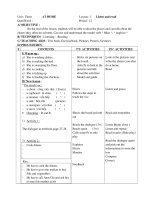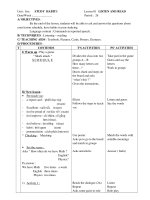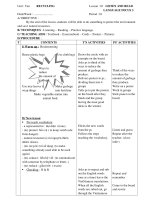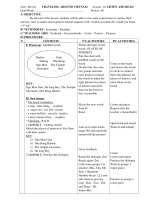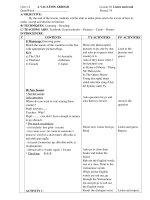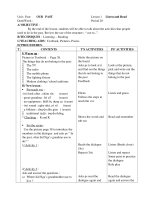E 8 Unit 03 Skills 2
Bạn đang xem bản rút gọn của tài liệu. Xem và tải ngay bản đầy đủ của tài liệu tại đây (1.73 MB, 14 trang )
Unit 3: Peoples of Viet Nam
Lesson
6:
Skills
2
New lesson
PEOPLES
OF VIETNAM
UNIT 3:
LESSON 6: SKILLS
2
Objectives
To listen for specific information about a
traditional dish.
- To write the recipe for a traditional dish.
-
I. LISTENING
1. Do you like sticky rice?
- Yes, I do. / - No, I
don’t.
2. When do we traditionally have sticky rice?
- Traditionally, we have sticky rice on
special occasions, such as at Tet, in
festivals and ceremonies, and whenever
1. Vocabulary:
- chemical /ˈkemɪkl / (n)
: hóa chất
- root / ruːt / (n)
: gốc, rễ
- leaf /liːf /(n) leaves /liːvz/ (pl) : lá (cây)
- harmony /ˈhɑːməni / (n)
: sự hài hòa
- represent /ˌreprɪˈzent / (v)
: đại diện cho
- element / ˈelɪmənt / (n)
: thành phần, yếu tố
- create / kriˈeɪt / (v)
: tạo ra
- heaven / ˈhevn/ (n)
: trời, thiên đường
2. Listen to the passage and tick (✔) true (T) or false (F).
Statements
1. Five-coloured sticky rice is a
traditional dish.
2. Five-coloured sticky rice is made
with chemicals.
natural roots and leaves
3. The colours represent the
elements of life.
T
F
✔
✔
✔
4. These elements create harmony
between people.
✔
5. This rice is only made when there
are guests.
on special occasions, for festivals ,ceremonies , and
✔
Heaven and earth
Five-coloured sticky rice is an
important traditional dish of many ethnic
minorities in the northern mountainous regions.
People call the dish five-coloured sticky rice
because it has five colours: red, yellow, green,
purple and white. The things that create the
colours are not chemicals but natural roots and
leaves. The five colours of the dish represent five
elements of life according to Vietnamese beliefs:
yellow is earth, red is fire, green is plants, white is
metal, and purple or black is water. People believe
that these five elements create harmony between
heaven and earth. Five-coloured sticky rice is
usually made and enjoyed at Tet, in festivals and
ceremonies, on special occasions, and whenever
Audio
script:
II.Writing:
How to make yellow sticky rice
4. Read the notes on how to make yellow sticky rice.
Sticky rice: 500g 1 tablespoon = 15ml
Turmeric: three tbsp extract
Shredded coconut: one cup
Salt: 1/4 tsp
1 teaspoon = 5ml
Notes:
1. Soak sticky rice – water – five hours +
2. Rinse rice – drain
3. Mix well w/ turmeric extract, wait – 10 mins.
4. Add coconut + salt – mix well
5. Steam – 30 mins – check cooked
6. Serve
5. Change the notes into cooking steps to show a
foreign visitor how to make yellow sticky rice.
Organising your ideas
Introducing your dish
This is a very easy dish to make
Try this delicious recipe
Signposting the cooking steps
First, Then, Next, After that, Finally
Once the (rice is rinsed), (add) the (salt)
Giving advice
Remember to… = Don’t forget to…
Try to…
Concluding
Serve this dish with…
This dish is delicious with
Example:
This delicious dish is very easy to make.
First, you need to soak the sticky rice for at least five hours…
5. Change the notes into cooking steps to show a
foreign visitor how to make yellow sticky rice.
Example 1:
This delicious dish is very easy to make. First,
you need to soak the sticky rice for at least five
hours. Secondly, you need to rinse rice. Once the
rice is rinsed, remember to mix well with turmeric
extract and wait for about ten minutes. Don't
forget to add coconut and salt, then mix well the
mixture. Finally steam for 30 minutes and
remember to check and see if it's cooked. Serve
this with salted shredded meat. It's better to
serve hot.
Homework
1. Practise listening
2. Prepare unit 3 looking back+ project
GOOD BYE
3. Listen again and complete the sentences.
1.
Five-coloured sticky rice is made by ethnic
minorities in the northern
_______________
mountainous regions.
2. The dish has five colours: red, yellow, green,
______________
purple / black and white.
3. It is made using _____natural
__________ roots
and leaves.
plants
4. The green colour symbolises _____________.
5. Five-coloured sticky rice is made on special
occasions, for festivals and _______________.
ceremonies

